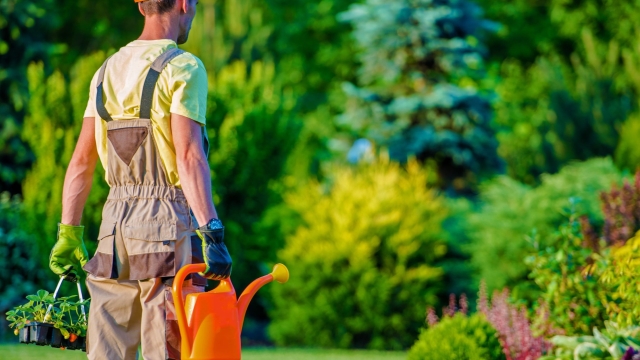
Gardening can be a rewarding and fulfilling hobby that brings a sense of peace and a connection to nature. Whether you have a sprawling backyard or just a few pots on a balcony, there are endless possibilities to explore. With the right techniques and knowledge, anyone can cultivate a vibrant garden that thrives and blooms.
In this article, we will share clever gardening tips designed to help you maximize your green space. From selecting the right plants for your environment to effective watering strategies, these insights will empower you to nurture your garden with confidence. Let’s dig into some practical advice that will turn your gardening endeavors into a flourishing success.
Selecting the Right Plants
When starting a garden, selecting the right plants is crucial for ensuring a thriving landscape. Consider your local climate, soil type, and the amount of sunlight your garden receives throughout the day. Native plants are often a great choice as they are adapted to the local environment and require less maintenance. Additionally, think about the purpose of your garden—whether you want flowers for beauty, herbs for cooking, or vegetables for eating.
It’s also important to assess the relationship between different plants. Some plants can benefit each other when grown in proximity, while others may hinder growth. Companion planting is a technique where you intentionally pair plants that support each other’s growth, helping you to make the most of your garden space. Researching and planning your plant selections carefully can lead to a more fruitful garden overall.
Lastly, be mindful of the size and growth habits of your chosen plants. Understanding how large they will grow and how they will spread is essential for spacing them appropriately. Overcrowding can lead to unhealthy plants and diminished yields. By selecting plants that suit your garden’s specific conditions and keeping their growth patterns in mind, you set the stage for a flourishing garden that brings joy and beauty all season long.
Soil and Fertilization Basics
The foundation of a thriving garden lies in its soil. Healthy soil is rich in organic matter and provides essential nutrients for plant growth. To ensure your soil is optimal, consider conducting a soil test. This will give you valuable insights into its pH level and nutrient content, helping you make informed decisions about amendments. Incorporating organic materials like compost or well-rotted manure enhances soil structure and fertility, promoting better root development and overall plant health.
Fertilization is a crucial aspect of supporting your plants as they grow. Understanding the different types of fertilizers can help you choose the right one for your garden. Organic fertilizers, such as bone meal or fish emulsion, release nutrients gradually, feeding your plants over time. In contrast, synthetic fertilizers offer a quick nutrient boost. It’s important to follow the recommended application rates to prevent nutrient burn and to time your fertilization according to the specific needs of your plants, typically during their active growing season.
Additionally, consider using mulch as a companion to your soil and fertilization efforts. Mulch helps retain moisture, suppress weeds, and as it breaks down, it adds organic matter back into the soil. A layer of mulch around your plants can significantly improve both soil quality and plant health. By mastering these basics of soil and fertilization, you set the stage for a flourishing garden that thrives and blooms throughout the seasons.
Watering Techniques for Success
Get The Best Price
Effective watering is crucial for healthy plants and a thriving garden. Understanding the specific needs of your plants is the first step in developing a successful watering routine. Factors such as plant type, soil moisture, and weather conditions will influence how much and how often you water. It’s important to observe your plants for any signs of stress, such as wilting or discoloration, which can indicate underwatering or overwatering.
One technique to enhance water absorption is deep watering. Instead of brief, frequent watering sessions, aim for less frequent but more thorough watering. This encourages roots to grow deeper into the soil, making them more resilient during dry spells. Use a soaker hose or drip irrigation system to efficiently deliver water directly to the root zone, reducing evaporation and ensuring that moisture penetrates deeply into the soil.
Timing your watering is also essential. The best times to water are early in the morning or late in the afternoon. Watering during these cooler parts of the day minimizes evaporation and allows plants to absorb moisture before the heat of the day sets in. Additionally, always check the soil moisture before watering; if the top inch of soil is dry, it’s time to water. This mindful approach helps you develop a watering routine that supports optimal growth and vibrant blooms.
Pest Management Strategies
Maintaining a healthy garden often requires a proactive approach to pest management. One effective strategy is the use of companion planting, which involves growing mutually beneficial plants together. For example, marigolds can deter nematodes and aphids when planted alongside vegetables. These natural allies not only enhance the garden’s biodiversity but also create a more resilient growing environment.
Another approach is implementing natural predators. Ladybugs and lacewings are well-known for their ability to control aphid populations. By attracting these beneficial insects to your garden, you help ensure that pest populations are kept in check without the use of chemical pesticides. You can encourage these allies by incorporating native plants and providing habitats such as insect hotels.
Finally, regular monitoring and manual removal can greatly reduce pest impact. Walk through your garden frequently to check for signs of trouble, such as chewed leaves or webbing. If you spot pests, consider hand-picking them off plants or using a strong jet of water to dislodge them. This hands-on approach not only helps control pests but also fosters a deeper connection with your garden.
Seasonal Gardening Tips
As spring arrives, it’s the perfect time to prepare your garden for a vibrant growing season. Start by clearing out any debris and dead plants from the previous year to create a clean slate. Test your soil and amend it with compost to enhance its fertility. Choosing the right plants that thrive in your climate is crucial; consider starting seeds indoors for an early start or directly sowing hardy varieties like peas and radishes outside.
Summer heat can be intense, so it’s essential to focus on watering techniques to keep your garden flourishing. Early morning is the best time to water, as it allows plants to absorb moisture before the sun gets too strong. Mulching around plants helps retain soil moisture and reduces the growth of weeds. Additionally, consider adding shade cloths for delicate plants if temperatures soar, providing them some respite from direct sunlight.
As autumn sets in, it’s time to prepare for the cooler months ahead. Harvest your crops regularly to encourage continued growth and avoid overripening. This is also a good time to plant fall crops like kale and garlic, which can thrive in cooler weather. Finally, consider protecting your garden with a layer of mulch or frost cloth as temperatures begin to drop, ensuring your plants stay healthy and ready to bloom again in spring.
















